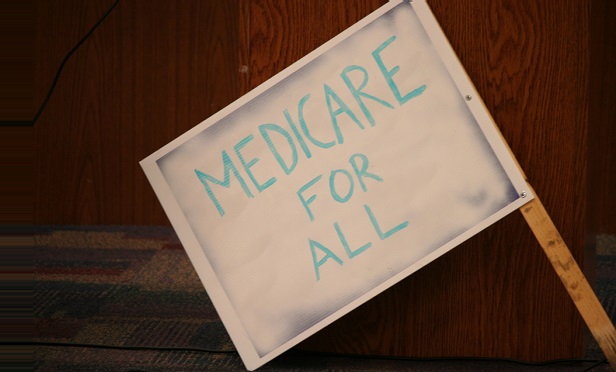 One financing option? A mandatory public premium averaging $7,500 per capita – the equivalent of $12,000 per individual not otherwise on public insurance. (Photo: Shutterstock)
One financing option? A mandatory public premium averaging $7,500 per capita – the equivalent of $12,000 per individual not otherwise on public insurance. (Photo: Shutterstock)
A preliminary estimate of the financing burden of a Medicare for All plan recently released by the Committee for a Responsible Federal Budget (CRFB) consists of a list unpalatable choices, suggesting that the committee is not all that keen on a single-payer health care system for Americans.
The report, "Choices for Financing Medicare for All: A Preliminary Analysis," describes nine ways to finance a Medicare for all system, assuming a $30 trillion price tag over the next decade—an number that is on the low side of some recent estimates.
Related: CBO: Medicare for All a 'major undertaking'
The report said such a figure could be financed by any one of the following measures:
- A 32 percent payroll tax.
- A 25 percent income surtax.
- A 42 percent value-added tax (VAT).
- A mandatory public premium averaging $7,500 per capita – the equivalent of $12,000 per individual not otherwise on public insurance.
- More than doubling all individual and corporate income tax rates.
- An 80 percent reduction in non-health federal spending.
- A 108 percent of Gross Domestic Product (GDP) increase in the national debt.
- "Impossibly high" taxes on high earners, corporations and the financial sector.
- A combination of approaches.
Different plans, different points of view
The CRFB, one of the nation's most prestigious economic think-tanks, is known for its hawkish view of deficits. The organization boasts an A-list of board members, including former Fed chairs Janet Yellin and Paul Volker; Reagan budget director David Stockman; and other high-profile policy makers and business leaders. As such, it's not known for embracing the kind of dramatic economic change that a Medicare for All system would represent.
The group's analysis came out at roughly the same time that presidential candidate Sen. Elizabeth Warren, D-MA, released a plan detailing how she would pay for her Medicare for All proposal. Warren had been under fire for not have specific numbers for her plan, and the new proposal is likely to be controversial as well. For example, Warren projects a ten-year price tag for her proposal at only $20 trillion.
Devil is in the details—and we're short on details
The CRFB, for its part, also lacks specifics, saying that it will follow up this estimate with more detailed reports. In this analysis, the approach of giving separate financing solutions their own cost estimates seems not entirely realistic, since any Medicare for All plan is likely to use a variety of ways to fund health care. For example, the paper simply labels taxes on corporations and high earners as "impossible," instead of considering that such taxes might somehow be in the mix—as it is with the Warren plan.
Michael Hiltzik, business columnist for the Los Angeles times, reviewed the CRFB proposal recently by wryly noting that since Halloween was coming up, the group picked a good time to "scare the hell" out of American taxpayers.
Hiltzik, who is generally more supportive of Medicare for All proposals, notes that even the CRFB analysis says that under some scenarios, Medicare for All might reduce health spending overall in the U.S. "Given the uncertainties about the details of any health care reform proposal, [the] argument that the committee is largely working out the 'distributional' issues that arise when revenues from taxes are substituted for premiums and co-pays looks a bit like placing one's thumb on the scale against Medicare for all," Hiltzik said.
Read more:
- Medicare for All: Where the 2020 presidential candidates stand
- Health insurers mount battle against Medicare for All
- Health care reform: Which path is the best?
© 2025 ALM Global, LLC, All Rights Reserved. Request academic re-use from www.copyright.com. All other uses, submit a request to [email protected]. For more information visit Asset & Logo Licensing.







